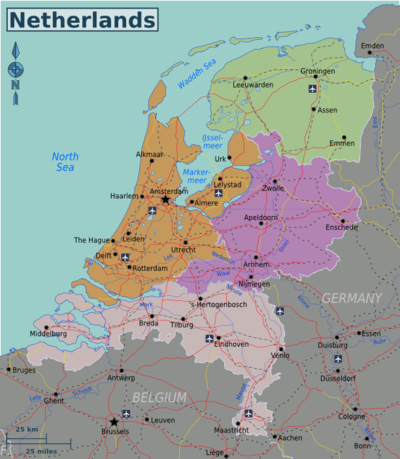Holland, northwest EuropeIt is a quaint and small country located in the low river delta of . Its landscape of famous flatlands, much of which has been reclaimed from the sea, is dotted with windmills, fields of blooming tulips and picturesque villages. With over 17 million people living in a relatively small area, this is a densely populated modern European country. Still, even the largest of its cities have retained a rather relaxed small-town atmosphere, and much of it is packed with historical heritage.
After the Eighty Years' War (1568-1648), which led to the country's "de facto" independence from Spain in 1581, the Netherlands became a major naval power and at one time one of the most powerful nations in the world. Due to its maritime and trade history; this small country has a rich cultural heritage that can be seen in many towns of the country. This period also formed a cultural peak where famous painters such as Rembrandt and Vermeer were trained. Their artifacts and other legacies fill world-class Dutch museums, attracting hundreds of thousands of visitors each year.
Over the centuries, the Netherlands has gained a reputation for tolerance and progressivism. The country was the first in the world to legalize same-sex marriage, and the Dutch often marijuana and to prostitution takes an open stance against it. EU and NATOThe Netherlands is at the center of international cooperation, as a founding member of the International Court of Justice and home to the International Court of Justice in The Hague.
international airport Schipholdeveloped motorway network and international High speed train With its lines, it is easy to reach the Netherlands from anywhere. Its small size, welcoming demeanor and interesting sights make it a unique and easy to explore destination and a great route to any European trip.
Regions
The Netherlands is a parliamentary monarchy administratively divided into 12 provinces. Although the Netherlands is a small country, these provinces are relatively diverse and have an abundance of cultural and linguistic differences. It is possible to divide them into four regions:

| West Netherlands (Flevoland, North Holland, south holland, Utrecht) This is the heart of the Netherlands with its four largest cities and the typical Dutch countryside with many monuments to its famous water management. Much of the area, referring to its urbanization Randstad is called. |
| North Holland (Drenthe, Friesland, Groningen) The least densely populated area, mostly unexplored by foreigners, but popular with locals. The West Frisian Islands are perfect destinations for a few days trips, as are the Frisian Lakes. |
| East Netherlands (Gelderland, Overijssel) Hoge Veluwe National Park, the largest national park in the Netherlands, as well as beautiful from Hanzeste, seven medieval cities with a traditional historical center along the IJssel River is home to routes such as Zutphen, Zwolle, Doesburg. |
| South Holland (Limburg, North Brabant, Zeeland) The Catholic history shared with Belgium is set apart from other regions by its carnival celebrations, beer culture and good food culture. |
This article describes the European Netherlands. Caribbean islands Bonaire, Sint Eustatius and Sabaare "special municipalities" fully integrated into the Netherlands. together with the Netherlands Aruba, Curacao and Sint Maarten; They are the constituent countries within the Kingdom of the Netherlands.
